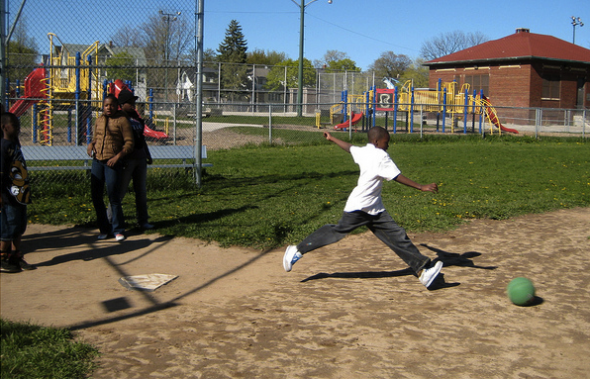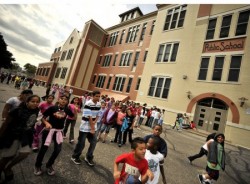How Good Are City’s After-School Programs?
New study by the Public Policy Forum finds strengths and weaknesses in programs for kids.

COA Goldin Center’s after-school program includes physical fitness, sports, homework help, computer and art classes, community service and cooking and nutrition education among other activities. (Photo by Andrea Waxman)
A Public Policy Forum (PPF) study of eight central city Milwaukee after-school program sites found that those with strong connections to schools and surrounding neighborhoods were best positioned to meet the needs of parents and students.
The analysis is part of a larger study examining the quality of hundreds of Milwaukee after-school programs and investigating policy barriers to quality improvements, according to Anneliese Dickman, research director at the PPF. Parents of children who participate or have recently participated in after-school programs were concerned about safety, convenience and the availability of engaging and structured activities, according to the report.
“They receive professional development training throughout the year,” said Prince.
Community Learning Centers is a program of the Milwaukee Public Schools Department of Recreation & Community Services.
The next phase of the study will look at professional development opportunities for after-school staff, according to Dickman. The study found that most parents were pleased with the quality and amount of programming available at the after-school sites located within five Local Initiative Support Corporation (LISC) neighborhoods including Harambee, Washington Park and Clarke Square. LISC is a national organization working to revitalize distressed urban areas.

The CLC site at Longfellow Elementary School offers academic enrichment, arts and music, drug and violence prevention and other programming.
Many parents said the programs had helped their children improve relationships with friends, social behaviors and self-confidence. The after-school programs studied included Community Learning Centers operating in partnerships with community organizations and district-operated or school-based programs.
Seventy-two percent of the after-school participants at the surveyed sites were African-American and 21 percent were Latino. Seventeen percent of the students were Spanish speakers. Forty-three percent of the students in those programs lived within walking distance of the sites.
Parents at South Side sites said the best aspects of those programs were their proximity and convenience, while North Side parents were more likely to consider quality of programming as the programs’ greatest strength.
Parents of middle and high school students cited a lack of safe and engaging after-school programs available to their children. Specifically, they said programming should include activities that were interesting to older students, but would also help them develop job and life skills.
Other concerns included costs. Parents felt strongly that after-school programs should be affordable or free. They did not think that costs for quality improvement should be passed on to parents, though nearly all parents surveyed said they were not being charged for the programs.
Parents also said that after-school programs should be more structured in order to improve student behavior. One factor that might influence children’s behavior, they said, would be an increase in communication between the day schools and the after-school programs. Parents said communication between their children’s classroom teachers and the staff at their after-school programs was almost non-existent. Tracking of homework assignments and goals for the tutoring component of the after-school programs sometimes relies on students rather than on coordination between program employees and teachers, parents said.
Longfellow’s CLC program does combine day school and after-school programming, according to Prince.
“We see our program as a continuation of the school day,” he said.
His staff works with teachers to create a pacing guide that ensures the lessons taught during the day are reinforced after school, he added.
Overall, parents see a strong correlation between the strength of relationships between schools and after-school programs and their children’s academic progress.
The study remarks that any changes to after-school programming should carefully consider affordability, convenience, safety and transportation to increase their appeal to parents of Milwaukee-area youth.
The next phase of the PPF study will look at supply and demand. We already know, Dickman said, that location is a big factor when choosing a program. “Most parents said they did not consider more than one program.”
This story was originally published by Milwaukee Neighborhood News Service, where you can find other stories reporting on fifteen city neighborhoods in Milwaukee.





















Thanks! I just want to clarify that we looked at programs serving every kind of Milwaukee student, not just MPS.